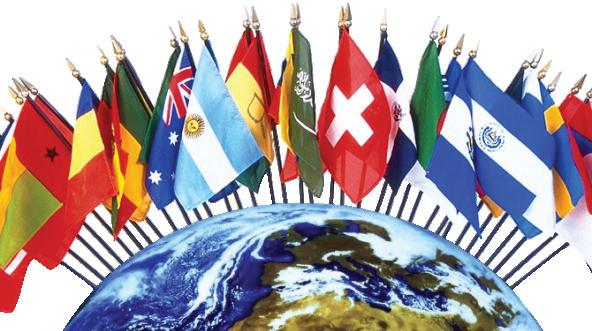
11 minute read
Fen Hampson: COVID-19 will depress global economy
COVID will dampen our economic future
Fen Hampson
Advertisement
As the coronavirus took its toxic flight around the globe and the health crisis in many countries — developed and developing alike — deepened, many pundits forecast that globalization was finally lurching to an ignominious end. “Davos Man will need rebranding,” one commentator cheekily observed in Forbes business magazine, arguing that the crisis was forcing many companies to reshore their overseas manufacturing operations. “New data shows U.S. companies are definitely leaving China,” blared another headline, underscoring mounting investor concerns about sourcing supply chains in China, where the pandemic originated.
“The coronavirus crisis has highlighted the downsides of extensive international integration while fanning fears of foreigners and providing legitimacy for national restrictions on global trade and flows of people,” observed Philippe Legrain in Foreign Policy magazine. “All sorts of businesses have suddenly realized the risks of relying on complex global supply chains that are specific not just to China — but to particular places such as Wuhan, the epicentre of the pandemic,” and “Chinese people — and now Italians, Iranians, Koreans, and others — have become widely seen as vectors of disease.”
Henry Farrell and Abraham Newman offered an equally Stygian prognosis in Foreign Affairs: “As critical supply chains break down, and nations hoard medical supplies and rush to limit travel, the crisis is forcing a major re-evaluation of the interconnected global economy,” they write. Furthermore, “[n]ot only has globalization allowed for the rapid spread of contagious disease, but it has fostered deep interdependence between firms and nations that makes them more vulnerable to unexpected shocks. Now, firms and nations alike are discovering just how vulnerable they are. But the lesson of the new coronavirus is not that globalization failed.
COVID-19 caused airlines to grind service to a halt. Its effects on the global economy will be vast.
The lesson is that globalization is fragile, despite or even because of its benefits.”
There is, of course, a grain of truth to these predictions. Some investors, who championed the virtues — and reaped the spoils — of doing business in China, are pulling up their grubstakes and catching the last flight home, while others are shifting their operations to other low-wage Asia-Pacific economies such as Vietnam, the Philippines or Mexico.
There can be no doubt that China’s leadership has not acquitted itself well during this crisis. Whether the fault ultimately lies with Beijing or senior officials in Hubei province or the former mayor of Wuhan (or all three), their concealment of the truth meant that precious time to alert the rest of the world and take proactive, preventive measures to nip the pandemic in the bud, was lost. However, Western leaders themselves also share the blame for dithering or downplaying the gravity of the situation and not restricting travel (especially to and from China). Though none was as reckless as Sweden, normally a paragon of prudence and good sense, whose leaders stumbled badly when they refused to adopt quarantine measures like their Scandinavian neighbours. Sweden’s chief epidemiologist, Anders Tegnell, the chief architect of the country’s response, smugly asserted that Sweden’s sophisticated and socially complaisant population would voluntarily adopt social distancing policies. When Sweden’s COVID death rates soared in early June, reaching one of the highest levels in the world on a per capita basis, even he was forced to finally admit that more should have been done to curb the spread of the virus.
China market remains crucial
Nevertheless, despite all the rhetoric about restructuring global supply chains to reduce dependence on China — especially for products such as personal protective equipment for medical workers, testing equipment and drugs that have been deemed critical to dealing with the pandemic — and also shunning business with the Chinese firm Huawei for 5G networks because of cybersecurity concerns, China will remain a crucial market for global trade and investment because of its sheer size and economic heft. It is just too important and significant to abruptly yank out of global supply chains.
In truth, China’s manufacturing knowhow, relative currency stability and domestic market for goods and services dwarf those of other emerging economies, including India, Brazil and Mexico. As Forbes’ writer Kenneth Rapoza underscores, China also has much lower corporate tax rates than its competitors, a cheaper wage structure than Brazil or Mexico, and a highly diversified manufacturing sector. Whatever you need can be produced more quickly and cheaply in China than just about anywhere else. The cost of moving goods within China and overseas is also much lower than other countries because of its state-of-the art ports and transportation system. On the corruption index, China is also viewed as a better place to do business than Brazil, Mexico, Vietnam or the Philippines, where stifling regulations and outdated infrastructure pose additional obstacles.
Nobody likes the current policies of the Chinese regime vis-à-vis Hong Kong, Taiwan or its own ethnic minorities, especially the Uighurs and Tibetan people, who have suffered years of repression and massive human rights abuses. The increasingly aggressive actions of China, which are no longer confined to the South China Sea, are a major source of global instability. All bets are off if tensions between the U.S. and China spiral uncontrollably upwards and there is armed confrontation. Rising trade tensions are also an important part of the global economic equation — not just COVID-19 and its aftermath.
A POST-COVID WORLD
MAY LEAD TO A MODEST
RESTRUCTURING OF SOME
GLOBAL VALUE CHAINS
AS GOVERNMENTS AND
COMPANIES REGULATE
SOURCES OF SUPPLY, ESPECIALLY FOR GOODS
DEEMED CRITICAL TO
[CITIZENS' HEALTH.]
However, the risks of escalating ChinaU.S. trade wars to the global economy have been accompanied by the reverse risks of a nascent “trade truce” as China and the U.S. try to patch their rift with new “managed” trade deals. These agreements don’t mark the end of globalization, but the onset of a new phase of “discriminatory globalization.” Phase 1 of the agreement between the U.S. and China, signed on Jan. 16, 2020, includes formal pledges to tighten rules on intellectual property protection, pirated goods and the theft of commercial property, to avoid currency manipulation and open China’s financial services sector to U.S. companies. More important, the pact commits China to buy an additional US$200 billion in American goods over the next two years, including US$40 billion to US$50 billion in agricultural products such as soybeans, canola, fresh and frozen pork, beef, wheat, corn, barley and a range of machinery, all on preferential terms unavailable to producers such as Canada.
A post-COVID world may lead to a modest restructuring of some global value chains as governments and companies regulate sources of supply, especially for goods deemed critical to the health of their citizenry or to strategic sectors of the economy (but they will cost more, which is the price of greater security). But COVID-19’s biggest impact will be on economic growth and prosperity. The U.S. Congressional Budget Office predicts that the effects of the coronavirus pandemic on the U.S. economy alone will be felt for at least a decade, reducing economic growth


Grocery store shelves, such as these at EsseLunga in Bergamo, Italy, were cleared out early in the pandemic as people hoarded staples.
by almost US$8 trillion and output by 3 per cent. Consumer spending — the main driver of U.S. economic growth — has been ravaged by job losses that are the biggest the U.S. has experienced since the Great Depression of the 1930s, leaving more than 40 million unemployed.
Job losses in the Eurozone have been equally staggering. By the end of April, they had reached 7 per cent of the total labour force and are projected to rise to 12 per cent or higher as job-subsidy schemes expire and the number of bankruptcies (especially for small businesses) balloon. What is even more disturbing is that youth are bearing the brunt of the pain. The unemployment rate for the under-25 age bracket in Europe has skyrocketed to nearly 16 per cent and is projected to grow, even under the best economic recovery scenario.
In Canada, unemployment levels rose steadily as many businesses shuttered or were forced to close permanently. At the height of the pandemic, Canada’s job losses spiked at 13 per cent or roughly three million people.
Gloomy and optimistic 2021 forecasts
The Paris-based Organisation for Economic Co-operation and Development (OECD) has offered two scenarios for the future, neither of which is good. In the OECD’s “double-hit scenario,” where there is a second wave of infections in 2020, which triggers a return to lockdown, world economic output will fall by 7.6 per cent in 2020, before climbing back 2.8 per cent in 2021. Under this scenario, the unemployment rate in OECD countries will double to nearly to 10 per cent with

Prime Minister Justin Trudeau gave daily press briefings between March 13 and the end of June. He scaled them back in July. little recovery in employment by 2021. In the second scenario where a second wave of infections is avoided, global economic activity will shrink by 6 per cent and unemployment levels will rise to 9.2 per cent, nearly double what they were before the crisis hit (5.4 per cent). Although living standards in this latter scenario will fall less sharply than in the first scenario, by year’s end 2021, OECD countries will have lost roughly five years’ equivalent of income growth.
Not everyone is so gloomy. Stephen Poloz, the outgoing governor of the Bank of Canada, sounded a rare note of cheery optimism at his final press conference in late May — no doubt elevated by the prospect of his own impending return to a lucrative life in the private sector. He opined that the Canadian economy would likely rebound fairly quickly after the worst of the crisis was over — Canada’s total economic output declined by 15 per cent (which translates into an 8.2-per-cent reduction in GDP) in the first quarter of the year — because growth would be triggered by a new wave of Schumpeterianstyle innovation as firms and employees adapt to their new circumstances (including working from home.)
In his seminal treatise, The Great Transformation, Austrian economist Joseph
Schumpeter described a “process of industrial mutation that incessantly revolutionizes the economic structure from within, incessantly destroying the old one, incessantly creating a new one.” Is COVID-19 one of those creative-destructive transformative moments as businesses and society adapt to a stay-at-home, online work culture? Maybe. But really, who knows?
One of the biggest drags on Canada’s post-crisis fortunes as well as those of other economies will be fiscal as governments foist higher taxes and cut spending to service the vast debt on the mountains of cash that they have been shovelling out in the form of subsidies, business loans and all kinds of sundry emergency payments during the pandemic.
The International Monetary Fund predicts that Canada’s debt burden postCOVID-19 will rise to 40 per cent of GDP in 2020 on a national accounts basis. But as Canadian economist Jack Mintz points out, the debt burden will actually be considerably higher if you include government employee pension plan liabilities and unfunded liabilities such as old age security, guaranteed income supplements, age-related tax credits, seniors’ drug plans, long-term care facilities and health-care

Public health officials administer temperature checks at an airport in Bologna, Italy.
benefits, all of which have taken a COVID hit. Put it all together and Canada has a debt burden of $3.2 trillion or roughly 166 per cent of GDP — four times higher than what the IMF calculates it to be.
The U.S. government’s $2.3-trillion stimulus package was the largest in U.S. history and included $1 trillion of forgivable loans to small businesses and direct payments to low- and middle-income families. That figure will likely double as trillions more are handed over to state and local governments and major corporations, which teeter on the verge of bankruptcy. The U.S. federal government’s public debt, which was forecast to rise to 100 per cent of total U.S. GDP in 2030, is now expected to be 28 per cent greater by then. It’s not going to be pretty when those bills come due.
Economists who have studied the relationship between the persistent accumulation of public debt over prolonged periods and economic growth find that the marriage is ultimately an unhappy one. Unconstrained spending binges invariably lead to lower levels of economic activity by “crowding out” the possibilities for private investment because of rising interest rates, reduced liquidity, higher taxes and greater uncertainty. That is the painful future we now confront.
Fen Hampson is Chancellor’s Professor at Carleton University. His latest book (with Derek H. Burney) is Braver Canada: Shaping our Destiny in a Precarious World.
Posted? I KN W corporate & INternational Moves
Follow me on social media:




613.837.0000
TeresaWhitmoreHomes.com Teresa@TeresaWhitmoreHomes.com










